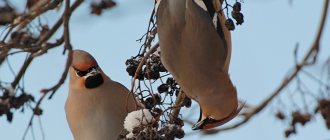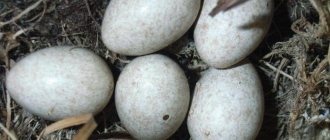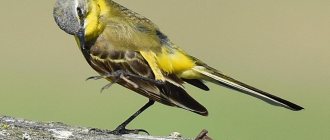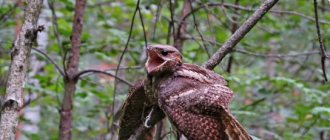- April 17, 2019
- Birds
- Natalia Egorenkova
Nature has its own view of how birds should look. Some are completely inconspicuous, others seem to be painted with the brush of a mad artist. And some were lucky enough to become the owners of a special decoration - a bunch of feathers on their heads.
We will tell you about the most famous birds with a crest that live in Russia and other countries of the world, we will describe their habitats and interesting features.
Waxwings
People call these birds Khokhliki, which very accurately conveys the main feature of their appearance. The waxwing is a small bird, about 23 cm in length and weighing up to 70 g.
The waxwing family and genus Waxwings includes only 3 species:
- The common waxwing is an inhabitant of the taiga zone.
- The Amur waxwing is a common bird in the Amur and Primorye regions. It is found in wintering grounds in China, Korea and Japan.
- The American waxwing is a typical inhabitant of the forests of Canada and the northern states of the United States.
All waxwings are birds with a crest. They are famous for their singing talent and insatiable eating of berries. Overripe fruits cause fermentation in the stomachs of birds, and the released alkaloids cause disorientation. You've probably heard stories about "drunk waxwings", which often end in tragedy. Birds hit the windows, bump into all surrounding objects and fall from the sky in flocks. Therefore, in the old days, their appearance and strange behavior were considered a bad omen.
Exotic with a tuft
The feathered inhabitants of distant hot countries, as a rule, look very elegant and bright. The crest, along with variegated plumage, is one of the characteristic colors of these birds.
The number of overseas birds that nature itself “crowned” includes:
- a cockatoo with a huge crest resembling a mohawk;
- the secretary bird (sagittarius serpentarius), which has a graceful physique, long legs, a crest, wings and a tail;
- peacock, including a rare white variety;
- northern cardinal, which has bright red feathers.
This list would be incomplete without the most exquisite tropical birds. We are talking about the mythical birds of paradise. This category includes 45 varieties. Most of them live in New Guinea. From this exotic variety, the six-feathered crested bird of paradise is distinguished. On her head are six bright feathers resembling a crown. Their size is disproportionately large compared to the length of the body, which looks very unusual.
If you learned something useful from this article, leave comments below and share with your friends on social networks.
The waxwing is a small bird, but quite bright. This feathered creature received its name due to the characteristic whistle that it makes. Only 8 species of birds can fully belong to the waxwing family. The most common species are silken and true waxwings, as well as shrikes. These feathered creatures are small in size, which is why they have never been actively hunted.
Waxwing is a small bird, but quite bright
Not all people know what this bird looks like. However, often, when they gather in large flocks, they become real pests, eating berries grown by people. For example, the American waxwing is a real threat to blueberry plantations. Birds often cannot swallow particularly large fruits, so after several attempts they simply throw them on the ground. They cause enormous damage to the farm, so farmers often resort to poisons, which can cause the death of a large number of these creatures.
Hoopoe
This is one of the most recognizable birds in the avifauna of the Old World. And all thanks to the long down-curved beak, luxurious orange-colored crest with black tips and contrasting black and white plumage of the wings and tail.
The popular names for hoopoe are dummy and tattoo. Probably due to the birds' habit of hiding, lying flat on the ground with their beak sticking up.
The hoopoe is a small bird. Its height usually does not exceed 30 cm, and its wingspan is about half a meter.
Hoopoes live in steppes, savannas and near arable fields throughout almost the entire territory of Eurasia and Africa, south of the Sahara Desert.
Lapwing
Another name for this bird is pigtail. The lapwing has a dense, round body on thin legs and a small head with a tuft of long feathers. The height of an adult bird is about 30 cm.
The lapwing is a bird with a characteristic black and white plumage and blunt wings, which distinguishes it from other related species. Despite this feature, lapwings are excellent flyers and during the mating season, males stage real aerial shows in front of females.
The range of lapwings is extremely large and extends from the Atlantic coast to the Pacific Ocean. The favorite habitats of these birds are damp meadows, which is why they are sometimes called meadows, as well as wetlands in forests.
Lapwings are very loud birds. In the old days they were not loved precisely because of their drawn-out, mournful cry, which was considered a harbinger of trouble. In the 20th century, the bird's reputation was restored, and everyone born in the USSR probably knows the cheerful children's song "Lapwing by the road."
How do waxwings live in nature?
These migratory birds prefer a flocking lifestyle. Typically, a group of waxwings includes more than 50 individuals. Particularly large flocks number about 150 thousand individuals. These feathered creatures, forced to roam to escape the cold, constantly change their diet. In the summer, when they are breeding, in the rich taiga forests they feed mainly on food of animal origin.
Their favorite dishes are:
Their excellent aerodynamic properties allow them to catch insects in flight. Waxwings are characterized by increased gluttony, so during the nesting period they can destroy an incredible number of forest pests. In winter, this bird switches to plant food. She prefers berries of all kinds.
Even despite severe cold, they linger in diets that contain a large number of seeds and berries of plants such as:
- viburnum;
- barberry;
- rose hip;
- Rowan;
- juniper;
- mulberry;
- lilac;
- mistletoe;
- cowberry;
- buckthorn;
- bird cherry;
- privet;
- hawthorn.
In early spring and autumn, birds living on such a diet may not behave quite adequately. Drunken waxwings are already a well-studied phenomenon. The thing is that they consume huge quantities of berries, in which, at a certain ambient temperature, a fermentation process is observed.
Thus, in the shortest possible time, waxwings can consume quite a lot of alcohol contained in the berries to get a little drunk. This condition is extremely dangerous for birds, as they can crash into various objects, causing injury. In some cases, this leads to the death of birds. In addition, this greatly worries people, because often these feathered creatures crash into houses.
The waxwing bird provides a significant service to many plants, as it facilitates the dispersal of seeds. These creatures have an increased metabolic rate, so they are forced to consume significant amounts of berries. After digestion, the seeds remain intact. Having passed through the intestines of the bird, they are sown at a considerable distance from the mother plant. After this treatment it is much easier for them to ascend.
Jay
Along with waxwings, the jay is one of the most famous forest birds with a crest. Adults grow up to 40 cm including the tail and weigh about 200 g. Their wide crest can stick up or look sleek.
The name of the bird comes from the Old Russian word “soy”, which meant “to shine”. Indeed, the jay's plumage is quite variegated: the body is brick-colored, the tail and wings are black, and the shoulders are turquoise.
These birds can be found in the forests of Europe, East Asia and northern Africa. Jays are famous for their amazing ability to imitate onomatopoeia. They easily imitate squeaks, knocks and even the human voice.
Waxwing: description
These birds are small in size, but they have quite brightly colored plumage. Today, the existence of nine species is known, constituting only 2 families - silky waxwings and simply waxwings, which in the past were classified as one family - the family of silky waxwings. In addition, they represent the order of passerines, and are also characterized by the very attractive color of their plumage. It should be noted that it is quite difficult to distinguish a female from a male.
The bird received its unusual name due to its unique singing, which is similar to the sounds made by a pipe. It is also worth noting that these birds move in the air quite quickly and in a straight line.
What does it look like
Adults grow on average to 20 cm and weigh about 60 grams. The bird is also distinguished by the presence of a characteristic and very noticeable crest on its head. The main color of the plumage is pink-gray with the presence of black, yellow and white feathers on the wings. The tail area, throat area, and eye area are painted black. The ends of the secondary flight wings are painted in bright red shades, which is especially striking at close range. The edge of the tail is painted bright yellow, which resembles a kind of stripe.
The color of the plumage depends on which species this beautiful bird belongs to. Amur or Japanese waxwings have slightly smaller body sizes (on average about 16 cm), and the tips of the tail feathers, as well as the wings themselves, are colored red. American or cedar waxwings have brighter and more attractive plumage colors. Common waxwings are characterized by a softer color, predominantly brown with black and yellow markings.
Interesting moment! Before the first moult, young individuals are colored brownish-gray, with a brownish-white color on the belly area. Birds are distinguished by the presence of a chestnut-colored undertail, as well as a bright yellow color present on the tail and on the wings.
Waxwings have a relatively short but wide beak, reminiscent of a flycatcher's beak. The mandible is straight, and the top of the mandible is somewhat curved. The bird has strong legs, armed with curved claws designed to securely grasp branches, while the bird's rapid movements are limited. The tail is relatively short, and the tail feathers are almost the same size. The wings are relatively long, having an apex formed by the third flight feather, as well as a vestigial first feather.
Behavior and lifestyle
It is believed that waxwings are sedentary birds, although during breeding periods they gather in numerous flocks and actively move in search of food. These birds molt only once a year, with the moulting period occurring in the October/November months. If adult individuals undergo complete molting, then for young individuals this process is partial, with the period of the first molting occurring in the last ten days of summer.
Already in September, young individuals develop a black spot in the throat area. With the onset of autumn, young birds change mainly their small plumage, and the rest of the plumage remains untouched until the autumn of next year.
How long does a waxwing live?
Waxwings are considered the closest relatives of sparrows, and can live in the natural environment for about 12 years. These birds are often kept in captivity, although they never become tame. Given comfortable living conditions in captivity, waxwings can live about 15 years.
Waxwing and interesting facts about it
Where does he live?
Amur or Japanese waxwings live in the northeastern part of Asia. They are also found within the Amur region, as well as in the north of Primorye. These unique birds winter in Japan and Korea, as well as in the northeastern provinces of China. The American or cedar waxwing lives in the forested areas of Canada, as well as in the northern United States. For the winter, these birds migrate to the southern United States, but they can also be found in other countries, such as Ukraine, Tajikistan, Kazakhstan, Kyrgyzstan, Uzbekistan, etc.
It is important to know! The natural habitats of waxwings are associated with green spaces, mainly coniferous trees, as well as birch groves. During nesting periods, these birds are found within deciduous forests.
Common waxwings, as a rule, live in the northern hemisphere, spreading into the taiga. In addition, this species is found in sparse coniferous forests, as well as areas with a predominance of mixed green spaces, in clearings, as well as in mountainous areas overgrown with vegetation. Waxwings fly south with the onset of real cold weather, as well as with the fall of the first snow.
Regardless of living conditions, waxwings leave for more comfortable regions no earlier than in the middle of the first autumn month. During the period from autumn to the first winter month, the most numerous flocks of waxwings are found. The return to their usual habitats is carried out, on the contrary, in small groups.
What does it eat?
It is typical for Amur or Japanese waxwings to feed on plant foods in the form of fruits and berries. With the onset of spring, they feed on the buds of various plants, and with the onset of summer, their diet expands significantly due to various insects, including harmful ones. Moving in groups, they easily catch insects on the fly, but do not reject various larvae, as well as young shoots of vegetation.
In the summer, birds use berries of various plants as food items of plant origin. The berries of viburnum, lingonberries, mistletoe, hawthorn, Siberian apple, juniper, rose hips, buckthorn and other fruit and berry bushes are eaten. In winter, the basis of the diet of these birds is the fruits of rowan, so groups of these birds can always be found in places where this plant grows.
Reproduction and offspring
Common waxwings are considered the most common species, therefore they are found in various biotopes and prefer to nest on tall trees in open forests. Already at the age of 1 year, these birds become sexually mature individuals. The breeding season begins at the time of active nesting, which occurs in May/July. The nest is formed at the very top of the tree and has a bowl-like shape. To build a nest, waxwings use various natural building components, such as grass, animal hair, dry moss, and small branches of trees or shrubs. The lower part of the nest, as a rule, is lined with softer materials, and for the walls of the nest, more durable materials are used, in the form of branches, including coniferous trees. Nests are mainly located within forest edges, near bodies of water, and also near other “family” pairs.
Waxwings acquire new partners every year. The courtship process involves the male feeding his partner various berries. After mating, the female lays an average of 5 eggs of a gray-blue hue with blackish-purple specks. The female incubates the eggs herself and this takes about 2 weeks. During this period, the male is busy feeding himself and the female with various food components, including those of animal origin in the form of various insects. After birth, within a couple of weeks, young birds become completely independent.
Which is very important! In August, all the juveniles begin to fly and begin to form numerous flocks for winter habitats.
Japanese or Amur waxwings prefer to nest in deciduous and cedar forest plantations, with their breeding season occurring during the peak of winter. The female lays eggs in a nest, which is usually built on fairly thin branches of tall trees. The nest is formed by various plant fibers. Each clutch consists of 2-7 eggs of a grayish-blue hue. The process of incubating eggs takes at least 1 week, and the entire process of the appearance of offspring followed by departure from the nest takes about 24 days. The offspring that are born are actively fed by both parents.
Natural enemies of waxwings
These birds have quite a lot of natural enemies, represented by animals of prey and birds of prey. We can say that these birds occupy a very important place in the natural food chain, which is associated with important natural processes of maintaining the ecosystem of our Planet.
Interesting to know! Many of the species do not have protective plumage coloring, which makes them noticeable to many natural enemies. The nests of these birds are destroyed by squirrels and many representatives of the weasel family.
As for the waxwings themselves, their role in regulating the number of various harmful insects is simply enormous. In addition, by eating berries, fruits, and seeds of various plants, these birds participate in the natural process of dispersal of many plants, herbs, trees and shrubs.
Tufted tit
The name of this bird speaks for itself. Thanks to its striking black and white conical crest, the tufted tit is often called a grenadier or grenadier.
The height of representatives of the species is from 11 to 14 cm, and they weigh only 14 g. The color of the plumage of the tufted tit is brownish-gray in the upper part and yellowish-white below.
This is an exclusively European bird, living in coniferous forests in the north of its range, and in deciduous forests closer to the south.
Also worth noting is the second species of the tufted tit genus - the gray-crested tit. This inconspicuous gray bird with a tuft lives in the tropical rainforests of South and East Asia.
Lifestyle and habitat
Most residents of the northern hemisphere know what a waxwing looks like Representatives of the family are not found in the south.
The biotope of distribution of the hero of the article is impressive:
- firstly, the bird is found at any altitude, equally common in both lowlands and mountains
- secondly, the waxwing is found both in forests and in clearings, whether dry or swampy.
The main thing is that there are berries in the selected areas. The relative preferences of passerines are places with the simultaneous presence of spruce and birch trees. These are the first ones that come to mind when asked where waxwings live .
They are not sedentary, but they cannot be called migratory birds either. The middle option is nomadic birds. This is exactly what waxwings are. They fly from place to place in search of food.
Amur waxwing
Waxwings live in flocks. The sonorous voices of birds are heard throughout the area. Birds often whistle. Hence the name of the animals. Sometimes the bird's voice rings like a bell. This enriches the singing of the waxwing .
Listen to the voice of the waxwing
In a conversation on the topic of how waxwings sing , the issue of singing volume is important. It's loud. It’s not for nothing that in the Old Russian language the word “waxy” means “cry”. It is inherent in all species of the genus, however, despite the volume, it is melodic.
Oatmeal-remez
The genus of true buntings includes about 40 species of birds. But only the remez bunting has a distinctive feature - a well-defined crest on the head. This is a small bird, up to 15 cm long and weighing about 20 g.
During the nesting period, the remez bunting is found in damp coniferous forests of northern latitudes: from Scandinavia to the Bering Strait. These birds winter in the eastern regions of China and Japan.
Toucan
The toucan is a remarkable, bright bird that stands out among birds not only for its color, but also for its unique temperament. The toucan is considered an exotic bird, but today it can be seen in many zoos.
They are easy to tame, which makes it possible to keep them even at home. The toucan family includes a large number of different species, but they are all very similar. The first thing I would like to note is their bright and large beak - everyone has one, and inside it hides a long tongue, with the help of which birds pick up food.
The toucan has a large beak, so it is difficult for the bird to maintain balance (the length of the beak is half the length of the body).
1 0
Great grebe
This waterfowl is very loved by illustrators of children's books, and all because of the original tufts of feathers on its head, forming 2 fluffy crests. It is interesting that birds only have this decoration in their spring plumage. The same goes for the red “collar” around the neck.
In the literature, the great grebe is more often found under the name grebe. It is slightly smaller in size than a duck. She has a thin flexible neck, a long beak and leathery membranes on her feet - everything necessary for an aquatic lifestyle.
Great grebes live in stagnant bodies of water throughout Eurasia, with the exception of the extreme northern regions, and are found in Australia and New Zealand, as well as in some areas of Africa.
Forest and waterfowl crested
Common birds that inhabit forests and wetlands are the sharp-crested woodpecker, jay, hoopoe, hoatzin and great grebe.
The woodpecker is known to be a forest nurse. Its specific head structure and peculiar long beak are designed to easily and effectively extract parasites from under the bark of a tree. As for appearance, the bird looks very colorful and bright. And the long crest is the calling card of the bird.
The small jay also has a crest that matches the color of its beige-brown or blue-black plumage. There are black and black and white head decorations. The inhabitant of deciduous and bush forests loves to feast on bugs, lizards, small rodents, and frogs. A strong beak curved at the end helps the bird get food.
Red cardinal
A very beautiful bird with a crest on its head, also known as the Virginia cardinal. Seven US states, including Virginia, consider the feathered beauty their official symbol.
It is easy to identify the male by its bright crimson plumage and black mask. Female red cardinals are gray-brown, with a faded mask and slight splashes of red on the chest, wings and crest. The birds' height is about 20 cm with an average body weight of 30 g.
Red cardinals are extremely unpretentious in their choice of habitats and feel great in various forests and city parks. Sometimes they are spotted even in Washington.
In addition to the eastern United States, red cardinals live in Mexico and some areas of Canada. Since the 18th century, birds were brought to Bermuda and Hawaii, where they successfully took root.
Reproduction and lifespan
During the mating season, the trills of males become especially loud and melodic. The groom puffs up his tail, sticks out his red chest, shows his girlfriend first his left side, then his right, turning and flapping his wings.
Having formed a pair, the female begins to build a cup-shaped dense nest on a low tree or in the upper branches of bushes, and the future father helps her. The clutch consists of 3-4 eggs, which have a greenish or bluish tint interspersed with gray or brown.
While the female incubates the clutch, the male entertains her with songs, and she sometimes quietly sings along. He feeds his chosen one, bringing insects and seeds. He drives away other birds with loud chirping and selflessly protects the nest from attacks by predators. Occasionally, the mother may leave the nest, then the male sits on the clutch.
After 12-14 days, the chicks appear. Their parents feed them exclusively insects. Around the 17th day, the chicks leave their father's nest, after which the female begins the next clutch, and the male feeds the previous offspring.
In their natural environment, red cardinals live from 10 to 15 years. In captivity, with proper maintenance, their life expectancy can increase to 30 years.
Himalayan monal
This is one of the most beautiful pheasants with an elegant tuft of feathers on its head. But unlike most other birds with a crest, only males have this decoration. Their plumage shimmers in the sun with copper, turquoise, green, purple, scarlet and other colors.
Females don't look as impressive. They are dark or light brown with cross shading. Males grow up to 70 cm in length including the tail, females are somewhat smaller.
The Himalayan manal prefers to live in the mountainous regions of the Himalayas, at an altitude of up to 5 km above sea level.
Enemies
The first enemies of these birds are martens and squirrels, which eat not only eggs, but also newly hatched chicks. Among the birds dangerous to waxwings are owls, hawks and even crows. Having figured out whether the waxwing is a migratory bird or not, people try to feed these beauties. As for communication, these birds are reluctant to contact people, but with great desire they fly to various feeders that are hung in parks and other recreation areas.
What kind of bird is the waxwing? It is better to start getting acquainted with the bright representative of the passerine order in winter, when beautifully colored nimble birds with a clearly visible crest flash against the background of snow and scarlet rowan clusters.
Waxwing on a branch in winter.
The waxwing received this name due to its murmuring song “svi-ri-ri-ri-ri”, reminiscent of the sound of a pipe. For the same reason, birds are often associated with objects of folk art - painted toys - whistles, an invariable attribute of shepherds.
There are only 9 species of waxwings in the world, most of which have been studied very little.
Crowned pigeons
Birds of extraordinary beauty, whose heads are crowned not just with crests, but with real crowns.
The genus of crowned pigeons includes 3 species, and all of them live only on the island of Papua New Guinea:
- crowned pigeon;
- chestnut-breasted crowned pigeon;
- fan crowned pigeon.
Interestingly, males and females look exactly the same. However, they differ from pigeons in the usual sense not only in their crest and unusual plumage color, but also in size. The height of crowned pigeons reaches 80 cm, and they weigh about 2.5 kg.
The local population exterminated these birds for tasty meat, which led to a sharp decline in the population. Today, crowned pigeons are a vulnerable species and are protected by the state.
Migration.
Scientists used to argue about whether waxwings are migratory birds. They seemed to stay over the winter and feed on winter berries. However, thanks to closer observations, it was possible to find out that the waxwing is a nomadic bird. It is not the onset of cold weather that forces it to fly, but the disappearance of food sources. Therefore, when the usual diet becomes scarce, the birds unite in small flocks and fly to warmer climes. Waxwings do not fly far and return quickly.
Waxwing in flight
Secretary Bird
These birds of prey with a crest of black feathers are depicted on the coats of arms of South Africa and Sudan. Their unusual name is explained by the clear resemblance of the birds to court secretaries, who in the old days decorated their wigs with goose feathers.
The size of adult males and females ranges from 1.25 to 1.55 m. Secretaries weigh about 4 kg. They live in African savannas, where they hunt mainly snakes, but will not refuse to eat a lizard, frog, small animal or bird. In Africa, secretaries are highly respected and appreciated for the fact that they regularly carry out their noble mission of exterminating snakes.
Keeping waxwings at home.
Tufted birds are not so often found as poultry. This can be explained by their gluttony, lack of singing talent, as, for example, in nightingales, and reluctance to become attached to the owner. The waxwing calmly endures captivity, but does not express much warmth or affection towards the people who sheltered it.
Waxwings are caught using a net. Even an unprepared person can do this: these birds are very trusting and in the cold season it is easy to lure them with their favorite berries (cranberries, lingonberries, rowan).
These birds will need more space than other pets. He will like the aviary more than a cramped cage. This choice is also important for the physical health of the bird: at home they will continue to eat a lot, so they will need space for flights, otherwise the waxwings will quickly become obese.
Birds can live either alone or in pairs. They are peaceful and do not cause squabbles.
It is important for potential owners of crested birds to remember that these birds eat a lot compared to other birds of similar size. Therefore, you need to plan their diet especially carefully. Berries, fruits, and bird food consisting of insects and larvae are used as food. Waxwings are indifferent to grains and practically do not eat them.
When choosing enclosures or materials for them, it is necessary to take into account that waxwings are rather messy when eating. Additionally, birds eat and defecate frequently, so their habitat will need frequent cleaning.
Keeping waxwings at home is a complex and time-consuming task.
Waxwing in winter











